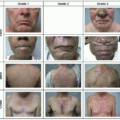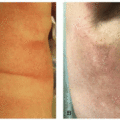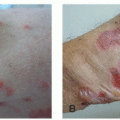Psoriasiform Reactions
Jordan Taylor Said
Jennifer T. Huang
Psoriasiform reactions are a specific subset of papulosquamous skin toxicities, thought to be induced by chemotherapy agents that impact keratinocyte proliferation, differentiation, and survival.1 Both de novo and exacerbation of pre-existing psoriasis have been described as skin toxicities. Of note, this toxicity is a relatively rare complication of some agents (ie, EGFR inhibitors, rituximab), but more commonly reported among patients receiving others (ie, interferon-alpha, immune checkpoint inhibitors (ICIs)).1 Lesions commonly present as sharply demarcated, dark pink-to-red plaques, with overlying thick or silvery scale (Figure 5.1). Guttate lesions, small 3 to 4 mm discrete scaly erythematous papules, have also been described (Figure 5.2). In patients with darker skin phototypes, the plaques may have a violaceous hue or redness may be less evident (Figure 5.3). Inverse psoriasis, a variant occurring in the intertriginous folds, can be difficult to distinguish from other causes of intertrigo, particularly in cancer patients. A thorough exam and history looking for other diagnostic clues is critical; lack of satellite pustules of candida, an oral exam revealing no evidence of lichen planus, and the presence of other classic findings of psoriasis on exam can be helpful. Importantly, virtually any body site can be involved, including the palms, soles, scalp, and nails. Nails may demonstrate pitting, onycholysis (“oil spots”), and splinter hemorrhages (Figure 5.4).
ICIs in particular have been demonstrated to induce a variety of de novo psoriasiform reactions, as well as exacerbate pre-existing psoriasis. Psoriasis may occur later than other ICI-mediated dermatologic adverse events; patients with a history of psoriasis tend to experience this toxicity earlier than de novo cases.2,3 Classical plaque psoriasis appears to be most common clinical phenotype induced by ICIs, but other variants reported include pustular, palmoplantar, guttate, nail, inverse, and erythrodermic psoriasis.2 In addition, patients should be screened for joint disease/involvement as psoriatic arthritis has also been reported in cases of ICI-induced psoriasis.
Stay updated, free articles. Join our Telegram channel

Full access? Get Clinical Tree







